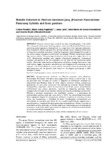Use este identificador para citar ou linkar para este item:
http://www.alice.cnptia.embrapa.br/alice/handle/doc/873028Registro completo de metadados
| Campo DC | Valor | Idioma |
|---|---|---|
| dc.contributor.author | PESSIM, C. | pt_BR |
| dc.contributor.author | PAGLIARINI, M. S. | pt_BR |
| dc.contributor.author | JANK, L. | pt_BR |
| dc.contributor.author | KANESHIMA, A. M. de S. | pt_BR |
| dc.contributor.author | BONATO, A. B. M. | pt_BR |
| dc.date.accessioned | 2011-04-09T16:07:42Z | - |
| dc.date.available | 2011-04-09T16:07:42Z | - |
| dc.date.created | 2011-01-13 | pt_BR |
| dc.date.issued | 2010 | pt_BR |
| dc.identifier.citation | Acta Scientiarum. Agronomy, v. 32, n. 3, p. 417-422, 2010. | pt_BR |
| dc.identifier.uri | http://www.alice.cnptia.embrapa.br/alice/handle/doc/873028 | pt_BR |
| dc.description | Panicum maximum Jacq. is one of the most cultivated grasses in the world. The intraspecific hybridization breeding program underway at Embrapa Beef Cattle aims at combining several agronomic characteristics in a single plant with high seed production. Four intraspecific hybrids originated from the cross between sexual tetraploid female plants with apomictic tetraploid male plants, including the genitors, were cytologically evaluated in the meiotic process throughout conventional methodology. Hybrids and genitors showed high meiotic stability. The percentage of abnormal cells among them ranged from 6.7 to 14.2%. Abnormalities recorded were irregular chromosome segregation, chromosome stickiness, and absence of the first cytokinesis, but the latter did not compromise pollen viability. Multivalent chromosome configurations at diakinesis, ranging from one to three quadrivalents, suggest that genetic recombination and introgression of some genes can be expected in the hybrids. Based on meiotic stability, the hybrids should be selected for high seed production, and the genitors could remain in the program participating in other intraspecific crosses. | pt_BR |
| dc.language.iso | por | pt_BR |
| dc.rights | openAccess | pt_BR |
| dc.subject | Programa de melhoramento | pt_BR |
| dc.subject | Híbridos interespecíficos | pt_BR |
| dc.title | Meiotic behavior in Panicum maximum Jacq. (Poaceae: Panicoideae: Paniceae): hybrids and their genitors. | pt_BR |
| dc.type | Artigo de periódico | pt_BR |
| dc.date.updated | 2011-04-10T11:11:11Z | pt_BR |
| dc.subject.thesagro | Características Agronômicas | pt_BR |
| dc.subject.thesagro | Meiose | pt_BR |
| dc.subject.thesagro | Gramínea Forrageira | pt_BR |
| dc.subject.thesagro | Panicum Maximum | pt_BR |
| dc.subject.thesagro | Melhoramento Genético Vegetal | pt_BR |
| dc.subject.thesagro | Pastagem | pt_BR |
| dc.subject.thesagro | Produção de Sementes | pt_BR |
| dc.subject.nalthesaurus | Panicum | pt_BR |
| dc.subject.nalthesaurus | Meiosis | pt_BR |
| riaa.ainfo.id | 873028 | pt_BR |
| riaa.ainfo.lastupdate | 2011-01-14 | pt_BR |
| dc.identifier.doi | https://doi.org/10.4025/actasciagron.v32i3.6461 | pt_BR |
| dc.contributor.institution | CLEIDE PESSIM, UNIVERSIDADE ESTADUAL DE MARINGÁ | pt_BR |
| dc.contributor.institution | MARIA SUELY PAGLIARINI, UNIVERSIDADE ESTADUAL DE MARINGÁ | pt_BR |
| dc.contributor.institution | LIANA JANK, CNPGC | pt_BR |
| dc.contributor.institution | ALICE MARIA DE SOUZA KANESHIMA, UNIVERSIDADE ESTADUAL DE MARINGÁ | pt_BR |
| dc.contributor.institution | ANDRÉA BEATRIZ MENDES BONATO, UNIVERSIDADE ESTADUAL DE MARINGÁ. | pt_BR |
| Aparece nas coleções: | Artigo em periódico indexado (CNPGC)  | |
Arquivos associados a este item:
| Arquivo | Descrição | Tamanho | Formato | |
|---|---|---|---|---|
| 6461403611PB1.pdf | 209,78 kB | Adobe PDF |  Visualizar/Abrir |









